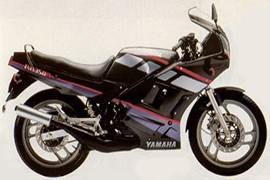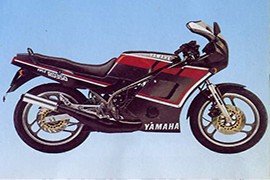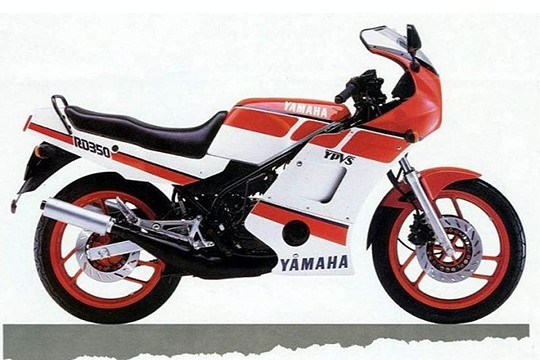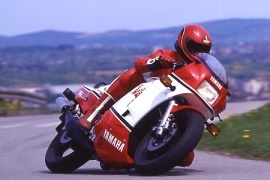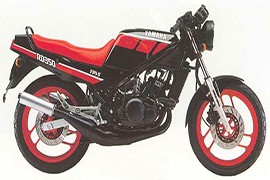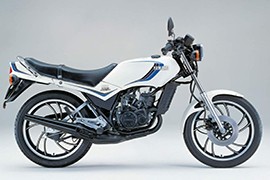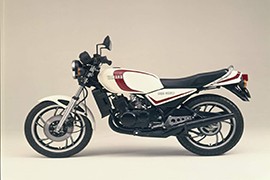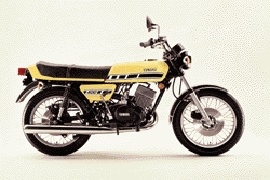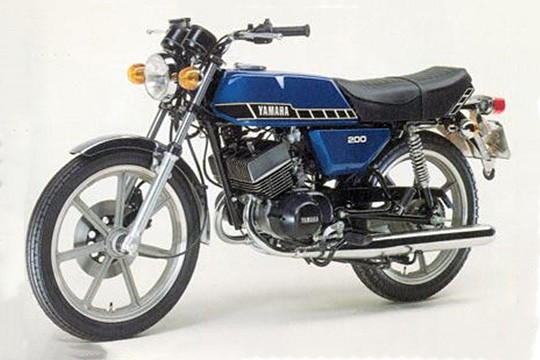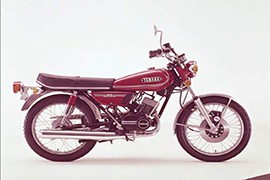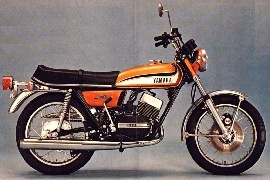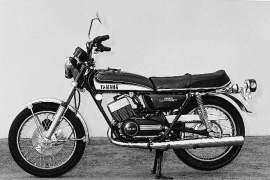YAMAHA RD Models/Series Timeline, Specifications & Photos
First production year: 1973
In 1992, the production of the RD 350 motorcycles was moved to Brazil, where the bike received a new name, RD 350R, and some modifications, including a new front fairing with two round headlights.
Other than that, the bike was pretty much similar to its predecessor. It packed standard features, such as a full fairing with two round headlights, a medium-sized windscreen, a single seat with a passenger grab handle, a dual-exhaust system, a side stand, and three-spoke aluminum wheels.
In the performance department, the 1990 Yamaha RD 350R had its heartbeat set by a 347cc two-stroke liquid-cooled parallel-twin engine fed by two Mikuni carburetors, offering an output power of 63 hp at 9,000 rpm and 49 Nm (36 lb-ft) torque at 9,000 rpm.
A six-speed manual transmission grabbed the power produced by the engine and sent it to the rear wheel through a final chain drive.
Suspension-wise, the motorcycle had installed a 35 mm air-assisted telescopic fork on the front with 140 mm of travel and a five-way preload adjustable shock absorber on the rear with 100 mm of travel.
The bike's braking performance was handled by two 260 mm discs coupled to dual-piston calipers on the front wheel and a 260 mm disc managed by a single-piston caliper on the rear wheel.
In 1987, the Japanese motorcycle manufacturer released the Yamaha RD 350 F2, a sports motorcycle that replaced the Yamaha RD 350 YPVS. It was designed similarly to its predecessor, packing almost the same features.
Visually, the RD 350 R2 was characterized by standard features, such as a full fairing, a rectangular headlight, a medium-sized windscreen, a one-piece dual seat with a pillion grab rail, a side stand, a dual exhaust system, and three double-spoke lightweight aluminum wheels.
The suspension system was retained from its predecessor, packing a 35 mm air-assisted telescopic fork with 140 mm wheel travel on the front and a five-position preload-adjustable rising-rate shock absorber on the rear, with 100 mm of travel.
The braking system comprised two 260 mm discs coupled to dual-piston calipers on the front wheel and a 260 mm disc engaged by a single-piston caliper on the rear wheel, delivering optimum braking performance.
In the performance department, the 1987 Yamaha RD 350 F2 had installed a 347cc two-stroke parallel-twin liquid-cooled engine that offered an output power of 63 hp with maximum strength at 9,000 rpm and 50 Nm (37 lb-ft) torque at 9,000 rpm.
All the power was transferred to a six-speed manual gearbox with a wet multi-plate clutch and sent to the rear end through a final chain drive.
The Yamaha RD 350F was a sports motorcycle made by Yamaha from 1985 to 1986. It was a small-displacement motorcycle with the Yamaha Power Valve System (YPVS) and dressed in a full fairing, as its name says.
In 1984, the Japanese motorcycle manufacturer launched the Yamaha RD 350F, a modern and street-legal sports motorcycle, but also the last two-stroke powered machine sold in the American market.
In the visual department, the bike was characterized by a full fairing with an integrated rectangular headlight, a medium-sized windscreen, a one-piece dual seat with a passenger grab handle, a dual exhaust system with a silencer mounted on each side, and three double-spoke aluminum wheels.
The bike was built around a double cradle steel frame with a 35 mm air-assisted telescopic fork on the front, offering 140 mm of travel, and a five-way adjustable shock absorber on the rear, delivering 100 mm of travel.
The bike's wheels were fitted with two 260 mm discs with dual-piston calipers on the front and a 260 mm disc tied to a single-piston caliper on the rear, providing optimum stopping power.
As for the power figures, the 1984 Yamaha RD 350F had its soul brought to life by a 347cc two-stroke parallel-twin liquid-cooled engine, boasting 59 hp with a peak force at 9,000 rpm and 41 Nm (40 lb-ft) torque at 8,000 rpm.
The Yamaha RD 500LC (Liquid Cooled) was a high-performance motorcycle manufactured by Yamaha for a short period. In Canada and Australia, the bike was known as the RZ 500. Also, a lightened and detuned version was manufactured for the Japanese home market under the RZV 500R designation.
In 1984, the Japanese motorcycle manufacturer launched the Yamaha RD 500LC, where RD stands for Race Developed and LC for Liquid Cooled. The bike was manufactured between 1984 and 1986 and became a sought-after motorcycle.
The bike's visual department was characterized by standard features, such as a full fairing, a rectangular headlight, a medium-sized windscreen, a single seat with a passenger seat cover, a pillion grab rail, and lightweight three double-spoke wheels.
The 1984 Yamaha RD 500LC had installed a 499cc two-stroke V4 liquid-cooled engine underneath its fuel tank, fed by four Mikuni carburetors, delivering 88 hp at 9,500 rpm and 66 Nm (48 lb-ft) torque at 8,500 rpm.
The engine was coupled to a six-speed manual transmission, sending the power to the rear wheel through a final chain drive, pushing the motorcycle to a top speed of 238 kph (148 mph).
Suspension-wise, the bike packed a 37 mm air-assisted telescopic fork with a variable anti-dive system and 140 mm wheel travel on the front. The rear end was handled by an adjustable shock absorber with 120 mm of travel.
The Yamaha RD 350 was a motorcycle made by Yamaha in 1983, replacing the Yamaha RD 350LC, and continued production until 1986 when it was succeeded by the RD 350 F2. It was presented at the Cologne motorcycle show and was the nearest thing to a road-going racer motorcycle ever produced at the time.
The bike was powered by a parallel-twin two-stroke engine with stroke and bore identical to its predecessor. It was the first motorcycle featuring the Yamaha Power Valve System (YPVS), revolutionizing the two-stroke engine.
In 1983, the Japanese motorcycle manufacturer launched the Yamaha RD 350N, a naked motorcycle fitted with standard features, such as a round headlight, a one-piece dual seat with a passenger grab rail, a dual exhaust system, and three double-spoke aluminum wheels.
In the performance department, the 1983 Yamaha RD 350N had its heartbeat set by a 347cc two-stroke twin-cylinder liquid-cooled engine fed by two Mikuni carburetors, delivering 59 hp with a peak force at 9,000 rpm and 47 Nm (35 lb-ft) torque at 8,000 rpm.
The bike's engine was coupled to a six-speed manual transmission with a wet multi-plate clutch and sent its power to the rear wheel through a final chain drive, pushing the motorcycle to a top speed of 188 kph (117 mph).
From top speed to a complete stop, the bike relied on two 267 mm discs with one-piston calipers on the front wheel and a single 267 mm disc with a single-piston caliper on the rear wheel.
The Yamaha RD 125LC was a motorcycle relaunched in 1982 as a new model and continued production until 1987. The new bike was fitted with a two-stroke single-cylinder liquid-cooled engine with a smaller displacement than its predecessor.
The RD 125LC model was pretty popular in countries with a small displacement limit for beginner riders, including England and Switzerland. Compared with other 125cc of the time, the RD 125LC had a more modern and sporty look and was ahead of the competition in performance.
In the visual department, the bike had standard features, such as a rectangular headlight, a one-piece dual seat with a passenger grab handle, a single exhaust system with a silencer mounted on the right side, and five double-spoke aluminum wheels.
It packed a 32 mm telescopic fork on the front for suspension and a 245 mm brake disc for stopping power. The rear end was handled by a six-way-adjustable monocross linkage on the rear and a 130 mm drum braking unit.
As for performance, the 1981 Yamaha RD 125LC had its soul brought to life by a 123cc two-stroke single-cylinder liquid-cooled engine fed by a carburetor, delivering 20 hp with maximum strength at 9,500 rpm and 16 Nm (12 lb-ft) torque at 9,250 rpm.
A six-speed manual transmission with a wet multi-plate clutch handled the bike's power and was sent to the rear wheel through a final chain drive, pushing the bike to 130 kph (81 mph).
The Yamaha RD 350LC was a motorcycle made by Yamaha from 1980 as a replacement for the Yamaha RD 400 until 1983 when it was replaced by the Yamaha RD 350 YPVS/RZ 350.
Although the bike succeeded the RD 400, it packed a smaller 347cc twin-cylinder engine with the same bore and stroke as its predecessor but with a liquid cooling system and several modifications in the intake and exhaust ports, complying with stricter emission regulations.
Compared to its predecessor, the RD 350LC had a more modern appearance, with standard features, such as a round headlight, a one-piece dual seat with a passenger grab rail, a dual-exhaust system with a muffler on both sides, a side stand, and a five double-spoke aluminum wheels.
In the performance department, the 1980 Yamaha RD 350LC had installed a 347cc two-stroke parallel-twin liquid-cooled engine underneath its fuel tank, delivering an output power of 47 hp with a peak force at 8,500 rpm and 41 Nm (30 lb-ft) torque at 8,000 rpm.
The bike was set in motion by a six-speed manual transmission with a wet multi-plate clutch and a final chain drive, spinning the rear wheel to a top speed of 183 kph (114 mph).
As for the braking performance, the machine was fitted with two 267 mm discs coupled to single-piston calipers on the front and a drum braking unit on the rear, providing optimum stopping power.
The Yamaha RD 400 was a standard motorcycle manufactured by Yamaha from 1976 as a replacement for the Yamaha RD 350 and continued production until 1979 when it was succeeded by the Yamaha RD 350LC.
In the American market, the bike was discontinued in the early 80s due to new emission regulations and continued to be sold worldwide until the late 1980s. In addition, the RD 400C was the first motorcycle made by a major manufacturer to be fitted with cast aluminum wheels.
In 1976, the Japanese motorcycle manufacturer launched the Yamaha RD 400, a motorcycle fitted with standard features, such as a round headlight up front, two instrument gauges mounted on top, a one-piece dual seat, side-mounted rear shocks, and seven-spoke cast wheels.
As for the power figures, the 1976 Yamaha RD 400 had installed a 398cc two-stroke air-cooled parallel-twin engine managed by two Mikuni carburetors, delivering 44 hp with a peak force at 7,500 rpm and 41 Nm (30 lb-ft) torque at 7,000 rpm.
The bike's engine worked in tandem with a six-speed manual transmission fitted with a wet multi-plate clutch, sending the power to the rear wheel through a final chain drive, pushing the bike to 172 kph (107 mph).
The bike packed a telescopic fork on the front for suspension and a 267 mm disc for braking power. In contrast, the rear end was handled by two side-mounted shock absorbers and a 267 mm brake disc.
The Yamaha RD 200 was a small-displacement motorcycle manufactured by the Japan-based company from 1972, continuing its production until 1981. The RD models were equipped with diaphragm control that improved torque and reduced consumption.
The bike was built around a tubular steel frame with three-way-adjustable spring struts (Soft, Medium, Hard). The pillion footpegs were attached to the swingarm, making the riding slightly uncomfortable for the passenger.
In the braking department, the Japanese version of the RD 200 was fitted with a disc brake on the front right from the start, while other versions were equipped with drum brakes both front and rear until 1976 when Yamaha replaced the front drum unit with a 245 mm disc.
In the aesthetic department, the bike was similar to the RD 125 model, packing standard features, such as a round headlight on the front with two instrument panels mounted on top, a one-piece dual seat, side-mounted rear shocks, and a dual exhaust system with a silencer on each side.
The 1974 Yamaha RD 200 had its heartbeat set by a 195cc two-stroke parallel-twin air-cooled engine fed by two carburetors, boasting 20 hp with a peak force at 8,000 rpm and 9 Nm (7 lb-ft) torque at 7,000 rpm.
The bike's 20 hp was handled by a five-speed manual transmission with a wet multi-plate clutch and sent to the rear end through a final chain drive.
The Yamaha RD 125 was a motorcycle manufactured by Yamaha from 1973 to 1990, with the RD designation that indicated its orientation for race development. The bike was largely similar to the AS3/AS2.
Compared to its predecessor, the RD 125 motorcycle had a teardrop-shaped fuel tank for a slimmer look, a 40 mm longer wheelbase, the air filter was moved under the side cover, and the oil filter neck under the seat.
In the visual department, the bike packed standard features, such as a round headlight with two instrument gauges mounted on top, a teardrop-shaped fuel tank, a two-piece dual seat, a dual exhaust system with a muffler on each side, and lightweight wire-spoke wheels.
The bike was built around a steel tube frame with a 28 mm telescopic fork on the front and a 150 mm drum braking unit. In contrast, the rear end was handled by preload-adjustable side-mounted shocks and a 130 mm drum unit.
As for the power figures, the 1973 Yamaha RD 125 had its soul brought to life by a 124cc two-stroke parallel-twin air-cooled engine, managed by two Teikei carburetors, delivering an output power of 17 hp with maximum strength at 8,500 rpm and 13 Nm (10 lb-ft) torque at 8,000 rpm.
The bike's engine was coupled to a five-speed manual transmission, sending the power to the rear wheel through a final chain drive, pushing the small motorcycle to 130 kph (81 mph).
The Yamaha RD 250 was a standard motorcycle manufactured by Yamaha from 1973 until 1987 when it was replaced by the Yamaha TRZ250. The bike was also known as the RZ 250 in the Japanese and Australian markets.
The bike was manufactured over four generations, including the air-cooled models from 1973 to 1979 and the liquid-cooled ones from 1980 to 1987, RD 250LT, RD 250 LC-II, and RD 250 YPVS. The RD suffix came from Race Developed.
In 1983, due to the high output power of the RD 250 motorcycle, the UK government reduced the maximum cc regulation for learners from 250 to 125cc. The RD 250cc was considered dangerous to be handled by new and inexperienced riders.
In the visual department, the bike was as simple as it gets, with standard features, such as a round headlight with two instrument gauges on top, a one-piece dual seat, a dual exhaust system, side-mounted shocks, chromed fenders, and wire-spoke wheels.
As for the power figures, the 1973 Yamaha RD 250 had installed a 247cc two-stroke parallel-twin air-cooled engine managed by two Mikuni carburetors, delivering 30 hp at 7,500 rpm and 28 Nm (21 lb-ft) torque at 7,000 rpm.
The power generated by the engine was handled by a six-speed manual transmission with a wet multi-plate clutch and sent to the rear wheel through a final chain drive.
The Yamaha RD 350 was a sports bike made by Yamaha starting in 1973, replacing the Yamaha R5 model, and it continued production until 1975 when it was replaced by the Yamaha RD400 model. The bike was powered by a two-stroke engine and evolved directly from the Yamaha R5.
All models were fitted with an Autolube (automatic oil injection) system, making it more manageable for the rider to put in gasoline without mixing it with two-stroke oil. The bike was sold in some markets with a six-speed manual transmission and in others with a five-speed unit.
The bike's frame dimensions were very similar to the Yamaha TZ 250 and TZ 350 factory road race machines, with weight and front fork rake differences, such as the 27 degrees on the RD and 25 degrees on the TZ series.
In the performance department, the 1973 Yamaha RD 350 had installed a 347cc two-stroke parallel twin-cylinder air-cooled engine fed by two Mikuni carburetors, delivering an output power of 39 hp with a peak force at 7,500 rpm and 33 Nm (24 lb-ft) torque at 7,000 rpm.
The bike's power was handled by a six-speed manual transmission with a wet multi-plate clutch and sent to the rear wheel through a final chain drive.
The bike was built around a double cradle steel frame with a telescopic fork on the front and dual side-mounted shock absorbers on the rear. The braking power was handled by a 267 mm disc with a dual-piston caliper on the front and a 178 mm drum unit on the rear.
